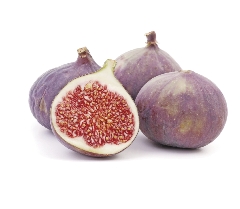
Fresh figs are a summer treat in the United States, arriving in June and disappearing by September. Tree-ripened figs can be scored at some local farmers’ markets in California, where 100% of dried figs and about 98% of fresh figs are grown.
Because the thin-skinned fruit is quite perishable, unripe figs are picked, shipped and left to ripen on supermarket shelves. The majority of figs produced in California, about 11,000 tons of them, are dried for year-round enjoyment. The Fresno, California–based Valley Fig Growers, a cooperative of 30 members, handles about 40% of the annual dried-fig crop.
Although there are more than 150 varieties of figs, purplish-black Mission and light-green Calimyrna figs are the most popular. Both are pear-shaped with a chewy texture and numerous seeds that provide a slight crunch. Fresh figs are sweet, rich and juicy, while dried figs boast a concentrated caramel taste.
The world’s first cultivated tree, the fig dates back to Biblical times and is native to the Middle East and Mediterranean regions. In the 16th century, Spaniards introduced figs to the Western hemisphere. In 1769, Spanish missionaries planted the first fig trees in San Diego; however, the figs from these trees were considered inferior to imports from Europe. In the early 1900s, California farmers focused on proper pollination and cultivation of figs and became some of the leading fig producers.
Nutritional Highlights. A good source of calcium, magnesium, potassium and iron, figs are also high in simple sugars and fiber. Three or four figs provide almost 100 milligrams of calcium.
Buying and Storing. Select fresh figs that are plump, tender, and free from bruises or shriveled skin. Refrigerate ripe figs and consume them within 2 days. Store unripe figs at room temperature, away from direct light. Rinse figs under cool water before eating them. Dried figs can be purchased year round and stored in a pantry for several months.
Uses. Enjoy whole, fresh figs out of hand when in season. No need to peel them. Try them quartered in a salad, with fresh yogurt or with goat cheese. Use puréed figs as a spread on whole-grain crackers or bread. Dried figs make a great snack on their own and can also be used in baked goods. See the Fig Squares Recipe for Health for a tasty dessert idea.
—Sarah Kruse
Sarah Kruse is a freelance writer and certified natural chef. She is a guest blogger at www.therapeuticchef.com.





